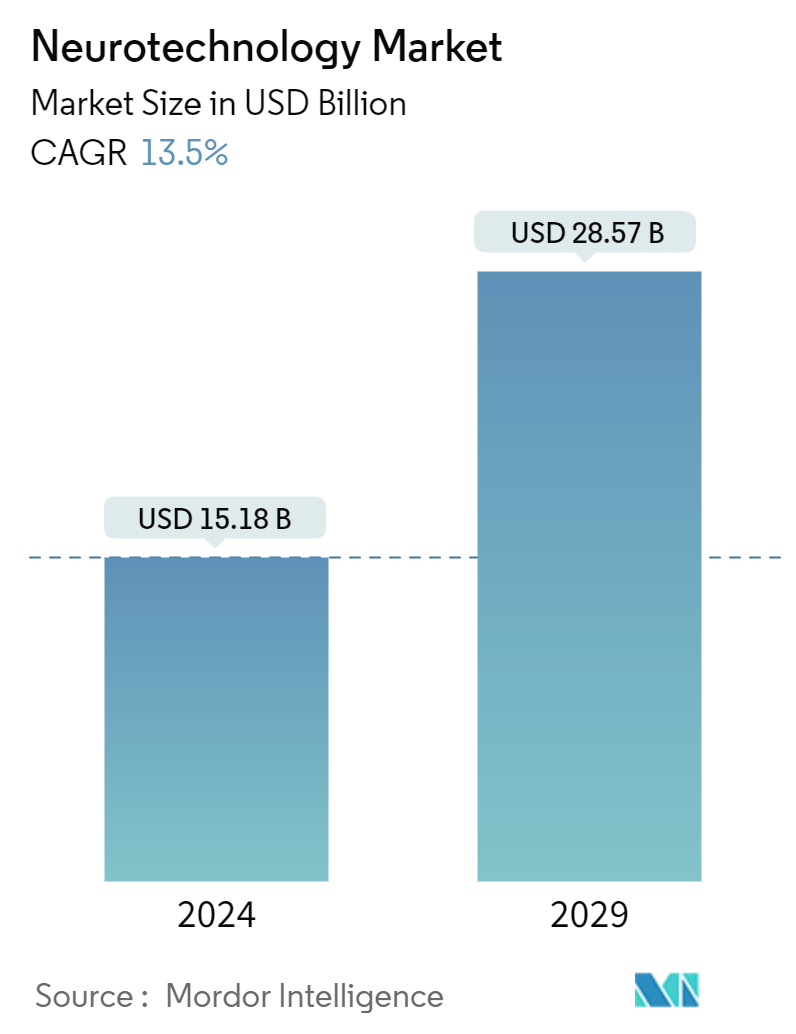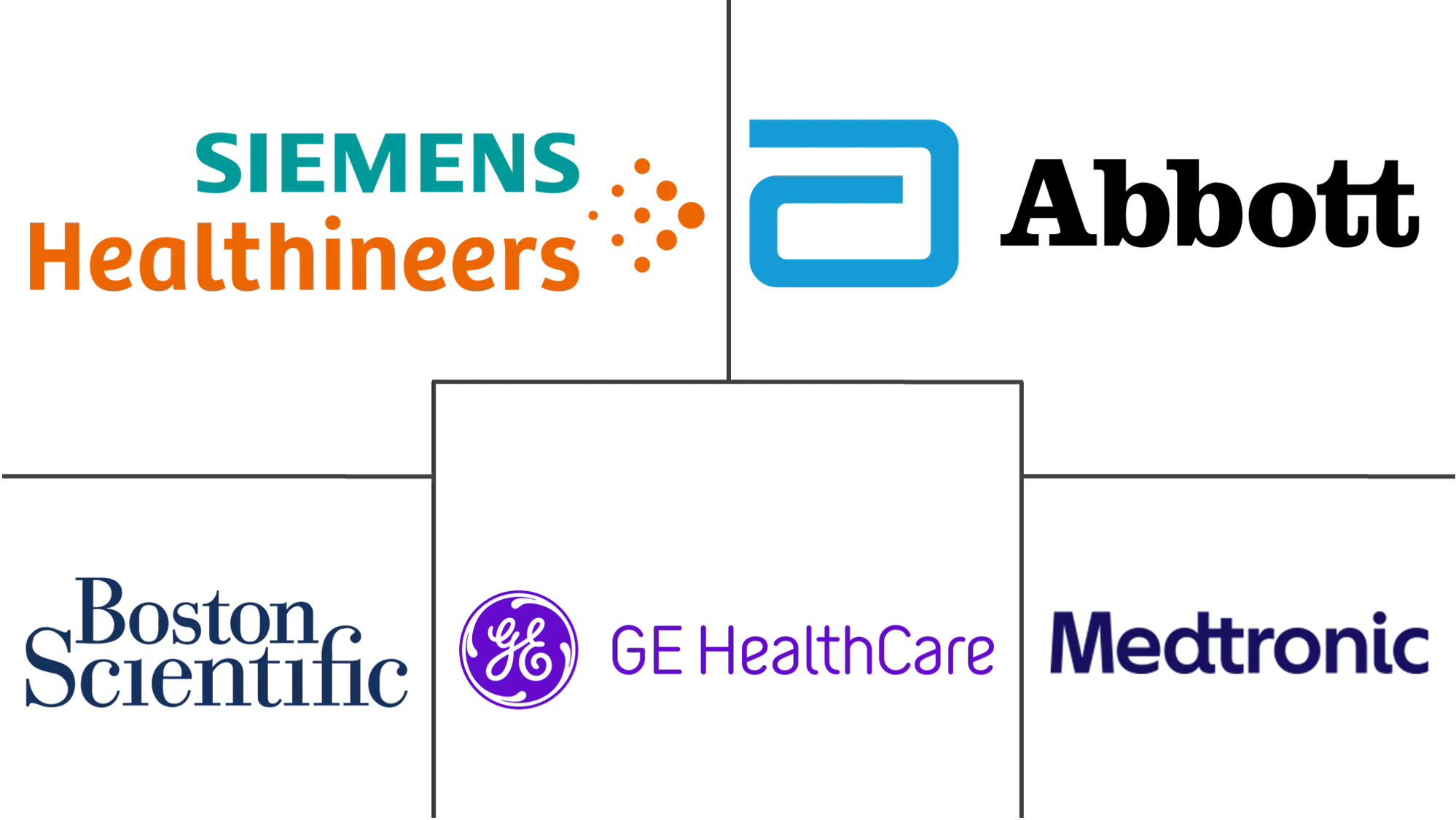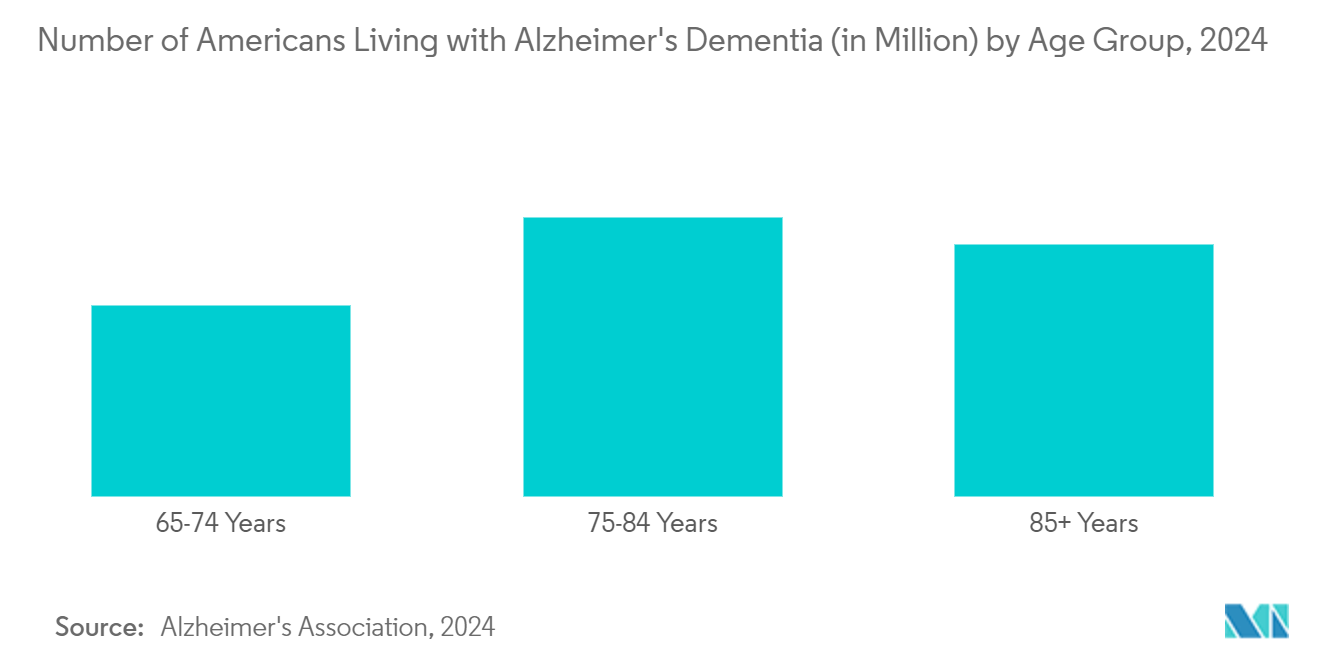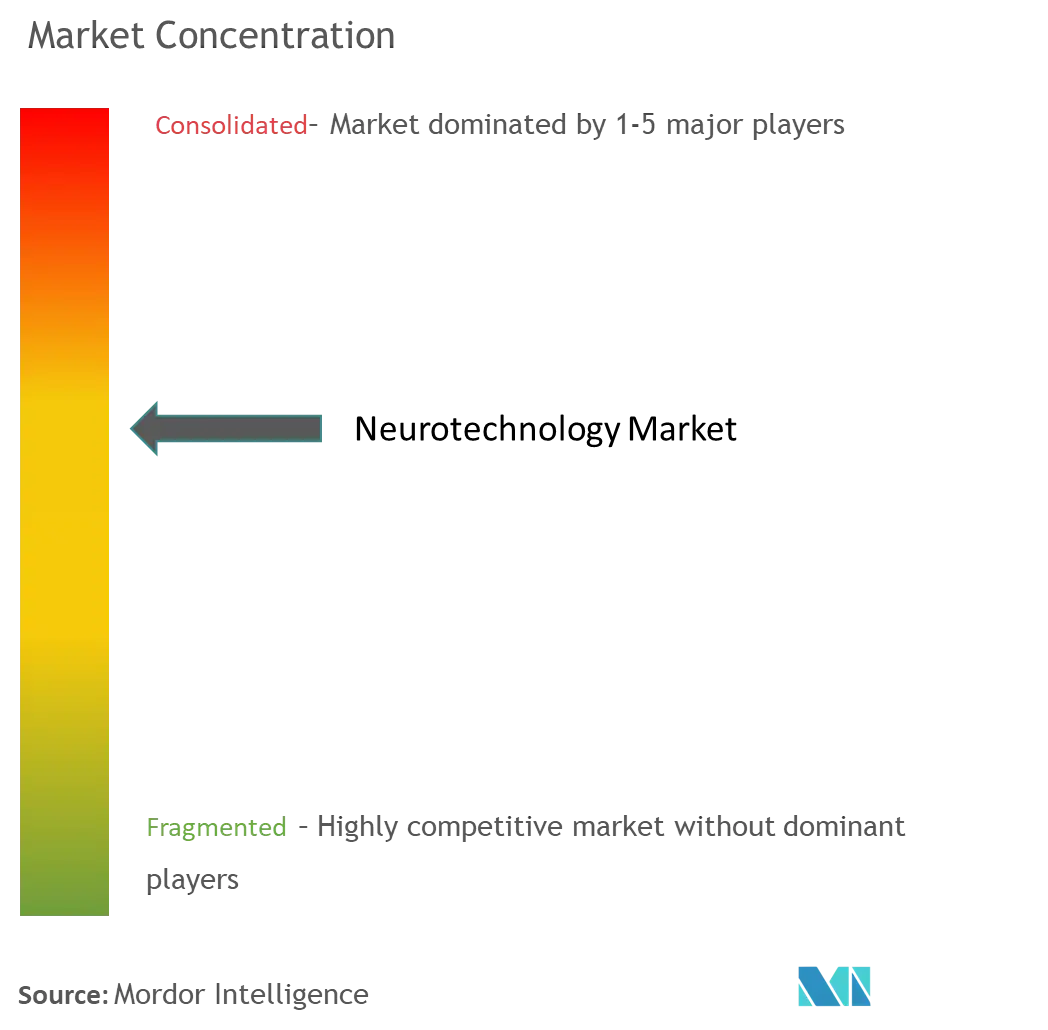Neurotechnology Market Size

| Study Period | 2019 - 2029 |
| Market Size (2024) | USD 15.18 Billion |
| Market Size (2029) | USD 28.57 Billion |
| CAGR (2024 - 2029) | 13.50 % |
| Fastest Growing Market | Asia Pacific |
| Largest Market | North America |
Major Players
*Disclaimer: Major Players sorted in no particular order |
Neurotechnology Market Analysis
The Neurotechnology Market size is estimated at USD 15.18 billion in 2024, and is expected to reach USD 28.57 billion by 2029, growing at a CAGR of 13.5% during the forecast period (2024-2029).
The factors that are driving the growth of the neuroelectronics market include the increasing prevalence of neurological disorders, rapid advancements in neuroscience and technology, and the rising demand for improved treatment options.
The rising incidence of neurological disorders, such as Alzheimer's disease, Parkinson's disease, epilepsy, and stroke, has led to a rising demand for effective diagnostic and therapeutic solutions. This situation is projected to drive the growth of the market during the forecast period. According to the Alzheimer’s Association 2024, published in Alzheimer's Disease Facts and Figures, the American population aged 65 years and above has been projected to grow from 58 million in 2021 to 88 million by 2050. As per the same source, an estimated 6.5 million Americans aged 65 years and above are expected to start suffering from Alzheimer’s disease by the end of 2024, and this number is estimated to reach 14 million by the end of 2060.
According to the data published by the National Institute of Neurological Disorders and Stroke in January 2024, Parkinson's disease (PD) is the second-most common neurodegenerative disorder in the United States, which affects around 5%-10% of the geriatric population of the country every year. As per the same source, approximately 500,000 citizens are diagnosed with Parkinson's disease every year.
According to the data published by the WHO in February 2024, more than 50 million people across the world suffer from epilepsy, making it one of the most common neurological diseases. Around 80% of people with epilepsy live in low- and middle-income countries. Estimates suggest that about 70% of people suffering from epilepsy could live seizure-free if they are properly diagnosed and treated. Thus, the rising number of people suffering from Alzheimer's disease, Parkinson's disease, and epilepsy is projected to drive the demand for neurotechnology products to offer new possibilities for early detection, precise diagnosis, and the targeted treatment of these conditions.
The rising number of product launches and approvals is also likely to drive the growth of the market during the forecast period. For instance, in May 2023, Abbott received the FDA's approval for its spinal cord stimulation (SCS) systems for treating chronic back pain in people who cannot undergo back surgery. This kind of back pain is known as non-surgical back pain. This new indication applies to Abbott's SCS in the United States, including the Eterna SCS platform and the Proclaim SCS family. In January 2023, Axonics Inc., a global medical technology company, received the United States Food and Drug Administration's approval for the company's fourth-generation rechargeable sacral neuromodulation system. Thus, the rising number of product approvals is projected to drive the growth of the market by boosting the availability of innovative products and increasing people's confidence in the safety and efficacy of products.
However, the high cost of development and the complex regulatory environment can hinder the growth of the market during the forecast period.
Neurotechnology Market Trends
Neurostimulation Devices Segment is Expected to Witness Significant Growth during the Forecast Period
Neurostimulation devices deliver electrical or magnetic stimulation to specific nerves or areas of the nervous system in order to modulate neural activity, which can be used for various therapeutic purposes, including pain management, treatment of neurological disorders, neuromodulation, and rehabilitation. These devices can be implanted or be used as external gadgets. They are designed to provide targeted and personalized therapy to patients suffering from chronic pain, movement disorders, psychiatric conditions, and other neurological conditions.
The major factors that are driving the growth of this market segment include rapidly rising technological advancements, patients' preferences for non-invasive and minimally invasive treatments, and the rising number of product launches. Neurostimulation devices are being increasingly used for a broader range of indications beyond traditional neurological disorders. They are now being explored for applications in pain management, obesity treatment, addiction therapy, and psychiatric disorders such as depression and anxiety, thereby expanding the addressable market and contributing to its rapid growth.
According to an article published by the American Academy of Neurology Journal in January 2022, neurostimulation devices are being approved for the treatment of movement disorders, epilepsy, pain, and depression. As per the same source, by 2035, advancements in the understanding of neuroanatomical networks, the mechanism of action in stimulation, the expanding scope of material science, miniaturization, energy storage facilities, and better delivery will lead to a higher usage of neurostimulation devices, which will significantly drive the growth of this market segment during the forecast period.
In addition, an increase in strategic activities by the key players, such as product launches and collaborations, and a surge in product approvals by the regulatory authorities will bolster the growth of the market. In January 2022, TensCare showcased its latest in transcutaneous electrical nerve stimulation at Arab Health 2022. This device is widely used for drug-free pain relief for the long-term treatment of chronic pain conditions such as diabetic neuropathy, backache, sciatica, osteoarthritis, and post-childbirth trauma.
In November 2022, ElectroCore Inc., a commercial-stage bioelectronic medicine company, received a unique national product code number from the Belgian Pharmaceutical Association for its gamma-core sapphire non-invasive vagus nerve stimulator (nVNS). Furthermore, in August 2022, Medtronic Private Limited launched the SenSight directional lead system for deep brain stimulation (DBS) therapy to treat symptoms associated with movement disorders and epilepsy in India.
Factors such as the rising number of product launches and rapid technological advancements are expected to drive the growth of the market during the forecast period.

North America is Expected to Witness Significant Growth during the Forecast Period
The North American market is likely to witness healthy growth, owing to factors like the rising geriatric population, increasing neurological disorders, and strategic product launches by the key players.
A significant number of people in the region are suffering from various neurological disorders, which is estimated to create a high demand for neurotechnology devices during the forecast period. According to the data updated by the Parkinson’s Foundation in January 2024, approximately 90,000 people in the United States are diagnosed with Parkinson's disease every year, and around 1.2 million people across the country are expected to live with Parkinson's disease by the end of 2030.
According to the data published by Statistics Canada in January 2024, approximately 750,000 Canadians suffer from Alzheimer's disease or other forms of dementia. In an article published by The Journal of Prevention of Alzheimer's Disease in October 2022, Alzheimer’s disease and other dementia-related diseases were ranked second among all neurological disorders that result in disability-adjusted life years (DALY) in Mexico. The rising number of neurological disorders in North America is projected to fuel the development of innovative neurotechnologies aimed at diagnosing and treating neurological disorders. These developments are expected to drive the growth of the North American market.
Furthermore, the rising number of product developments is projected to accelerate the growth of the market during the forecast period. In January 2024, Abbott received approval from the FDA to launch the Liberta RC DBS system, one of its smallest rechargeable deep brain stimulation (DBS) devices with remote programming, to treat people living with movement disorders.
In January 2022, Nevro Corp. received the FDA's approval for expanded labeling of its Senza Spinal Cord Stimulation (SCS) system for treating non-surgical refractory back pain (NSRBP). In January 2022, Medtronic received the FDA's approval for its Intellis rechargeable neurostimulator and Vanta recharge-free neurostimulator for treating chronic pain associated with diabetic peripheral neuropathy (DPN).
Thus, factors such as the rising instances of neurological disorders and the increasing number of product developments are projected to drive the growth of the regional market during the forecast period.

Neurotechnology Industry Overview
The neurotechnology market is semi-consolidated in nature due to the presence of several companies operating globally and regionally. The major players are continuously involved in various strategic activities, such as mergers, acquisitions, and partnerships. The competitive landscape includes a strong presence of local and regional companies that hold market shares and are well known, including Abbott, Boston Scientific, Medtronic, and GE Healthcare.
Neurotechnology Market Leaders
-
Abbott
-
Boston Scientific
-
Medtronic
-
GE Healthcare
-
Siemens Healthineers
*Disclaimer: Major Players sorted in no particular order

Neurotechnology Market News
- In March 2024, SetPoint Medical, a clinical-stage healthcare company, received a breakthrough device designation from the United States Food and Drug Administration (FDA) for the use of its novel neuroimmune modulation platform for people suffering from relapsing-remitting multiple sclerosis (RRMS).
- In May 2023, Cognixion, a developer of non-invasive brain-computer interface (BCI) and augmented reality (AR) technology, received the breakthrough device designation for its Cognixion ONE Axon machine.
Neurotechnology Market Report - Table of Contents
1. INTRODUCTION
- 1.1 Study Assumptions and Market Definition
- 1.2 Scope of the Study
2. RESEARCH METHODOLOGY
3. EXECUTIVE SUMMARY
4. MARKET DYNAMICS
- 4.1 Market Overview
-
4.2 Market Drivers
- 4.2.1 Rising Prevalence of Neurological Disorders
- 4.2.2 Surging Advancements in Neuroscience and Technology
- 4.2.3 Growing Demand for Improved Treatment Options
-
4.3 Market Restraints
- 4.3.1 High Cost of Neurotechnology Devices
- 4.3.2 Stringent Regulatory Framework
-
4.4 Porter's Five Force Analysis
- 4.4.1 Threat of New Entrants
- 4.4.2 Bargaining Power of Buyers/Consumers
- 4.4.3 Bargaining Power of Suppliers
- 4.4.4 Threat of Substitute Products
- 4.4.5 Intensity of Competitive Rivalry
5. MARKET SEGMENTATION (Market Size by Value - USD)
-
5.1 By Product Type
- 5.1.1 Neuroprosthetics
- 5.1.2 Neurostimulation Devices
- 5.1.3 Brain-Computer Interfaces
- 5.1.4 Other Products
-
5.2 By Application
- 5.2.1 Neurodegenerative Disorders
- 5.2.2 Neuropsychiatric Disorders
- 5.2.3 Chronic Pain Management
- 5.2.4 Other Applications
-
5.3 By End User
- 5.3.1 Hospitals and Clinics
- 5.3.2 Research Institutes and Academic Centers
- 5.3.3 Other End Users
-
5.4 Geography
- 5.4.1 North America
- 5.4.1.1 United States
- 5.4.1.2 Canada
- 5.4.1.3 Mexico
- 5.4.2 Europe
- 5.4.2.1 Germany
- 5.4.2.2 United Kingdom
- 5.4.2.3 France
- 5.4.2.4 Italy
- 5.4.2.5 Spain
- 5.4.2.6 Rest of Europe
- 5.4.3 Asia-Pacific
- 5.4.3.1 China
- 5.4.3.2 Japan
- 5.4.3.3 India
- 5.4.3.4 Australia
- 5.4.3.5 South Korea
- 5.4.3.6 Rest of Asia-Pacific
- 5.4.4 Middle East and Africa
- 5.4.4.1 GCC
- 5.4.4.2 South Africa
- 5.4.4.3 Rest of Middle East and Africa
- 5.4.5 South America
- 5.4.5.1 Brazil
- 5.4.5.2 Argentina
- 5.4.5.3 Rest of South America
6. COMPETITIVE LANDSCAPE
-
6.1 Company Profiles
- 6.1.1 Medtronic
- 6.1.2 Abbott Laboratories
- 6.1.3 Boston Scientific
- 6.1.4 Siemens Healthineers
- 6.1.5 GE Healthcare
- 6.1.6 LivaNova PLC
- 6.1.7 NeuroPace
- 6.1.8 Neuronetics
- 6.1.9 Koninklijke Philips N.V.
- 6.1.10 Elekta AB
- *List Not Exhaustive
7. MARKET OPPORTUNITIES AND FUTURE TRENDS
** Subject To AvailablityNeurotechnology Industry Segmentation
As per the scope of the report, neurotechnology refers to the interdisciplinary field that combines neuroscience, engineering, and computer science to develop tools, devices, and techniques for understanding, monitoring, and manipulating the nervous system. These technologies encompass a wide range of applications, including brain-computer interfaces, neural prosthetics, neuroimaging, neuromodulation, neuroinformatics, and neurosensing.
Based on the product type, the market is segmented into neuroprosthetics, neurostimulation devices, brain-computer interfaces, and other product types. Based on the application, the market is segmented into neurodegenerative disorders, neuropsychiatric disorders, chronic pain management, and other applications. Based on the end user, the market is segmented into hospitals and clinics, research institutes and academic centers, and other end users. This report also covers the market sizes and forecasts of 17 countries across major regions. For each segment, the market sizing and forecasts have been calculated in terms of USD.
| By Product Type | Neuroprosthetics | |
| Neurostimulation Devices | ||
| Brain-Computer Interfaces | ||
| Other Products | ||
| By Application | Neurodegenerative Disorders | |
| Neuropsychiatric Disorders | ||
| Chronic Pain Management | ||
| Other Applications | ||
| By End User | Hospitals and Clinics | |
| Research Institutes and Academic Centers | ||
| Other End Users | ||
| Geography | North America | United States |
| Canada | ||
| Mexico | ||
| Geography | Europe | Germany |
| United Kingdom | ||
| France | ||
| Italy | ||
| Spain | ||
| Rest of Europe | ||
| Geography | Asia-Pacific | China |
| Japan | ||
| India | ||
| Australia | ||
| South Korea | ||
| Rest of Asia-Pacific | ||
| Geography | Middle East and Africa | GCC |
| South Africa | ||
| Rest of Middle East and Africa | ||
| Geography | South America | Brazil |
| Argentina | ||
| Rest of South America |
Neurotechnology Market Research FAQs
How big is the Neurotechnology Market?
The Neurotechnology Market size is expected to reach USD 15.18 billion in 2024 and grow at a CAGR of 13.5% to reach USD 28.57 billion by 2029.
What is the current Neurotechnology Market size?
In 2024, the Neurotechnology Market size is expected to reach USD 15.18 billion.
Who are the key players in Neurotechnology Market?
Abbott, Boston Scientific, Medtronic, GE Healthcare and Siemens Healthineers are the major companies operating in the Neurotechnology Market.
Which is the fastest growing region in Neurotechnology Market?
Asia Pacific is estimated to grow at the highest CAGR over the forecast period (2024-2029).
Which region has the biggest share in Neurotechnology Market?
In 2024, the North America accounts for the largest market share in Neurotechnology Market.
What years does this Neurotechnology Market cover, and what was the market size in 2023?
In 2023, the Neurotechnology Market size was estimated at USD 13.13 billion. The report covers the Neurotechnology Market historical market size for years: 2019, 2020, 2021, 2022 and 2023. The report also forecasts the Neurotechnology Market size for years: 2024, 2025, 2026, 2027, 2028 and 2029.
Neurotechnology Industry Report
Statistics for the 2024 Neurotechnology market share, size and revenue growth rate, created by Mordor Intelligence™ Industry Reports. Neurotechnology analysis includes a market forecast outlook for 2024 to 2029 and historical overview. Get a sample of this industry analysis as a free report PDF download.



